Feasibility
- 格式:pdf
- 大小:141.81 KB
- 文档页数:12
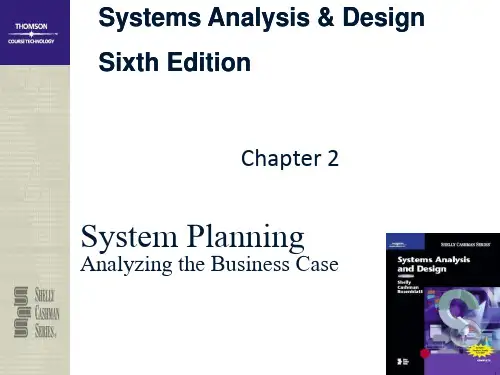
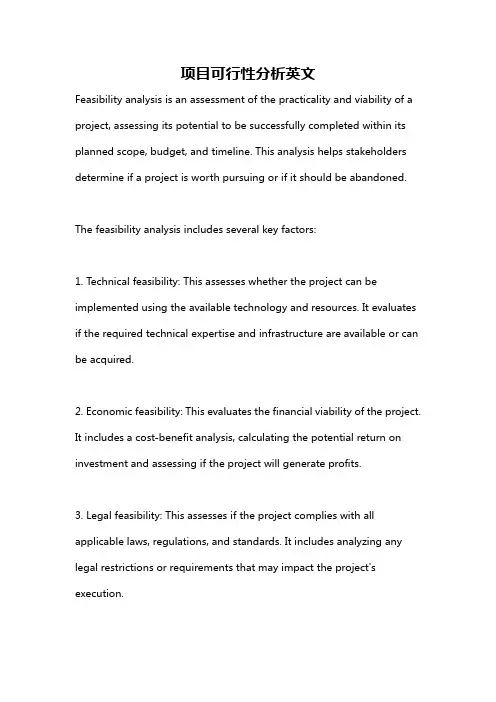
项目可行性分析英文Feasibility analysis is an assessment of the practicality and viability of a project, assessing its potential to be successfully completed within its planned scope, budget, and timeline. This analysis helps stakeholders determine if a project is worth pursuing or if it should be abandoned.The feasibility analysis includes several key factors:1. Technical feasibility: This assesses whether the project can be implemented using the available technology and resources. It evaluates if the required technical expertise and infrastructure are available or can be acquired.2. Economic feasibility: This evaluates the financial viability of the project. It includes a cost-benefit analysis, calculating the potential return on investment and assessing if the project will generate profits.3. Legal feasibility: This assesses if the project complies with all applicable laws, regulations, and standards. It includes analyzing any legal restrictions or requirements that may impact the project's execution.4. Operational feasibility: This evaluates whether the project aligns with the organization's current operations and capabilities. It considers if the project can be integrated seamlessly into existing processes and systems.5. Schedule feasibility: This assesses whether the project can be completed within the desired timeframe. It considers any dependencies, risks, and potential delays that may impact the project schedule.6. Market feasibility: This analyzes the market demand and competition for the project's products or services. It includes market research to determine if there is a viable market for the project and if it has a competitive advantage.7. Environmental feasibility: This assesses the impact of the project on the environment. It includes evaluating the project's compliance with environmental regulations, sustainability practices, and potential risks to the ecosystem.By conducting a thorough feasibility analysis, stakeholders can make informed decisions about whether to proceed with a project, make necessary adjustments, or abandon it altogether. This analysis helpsmitigate risks and increases the chances of project success.。
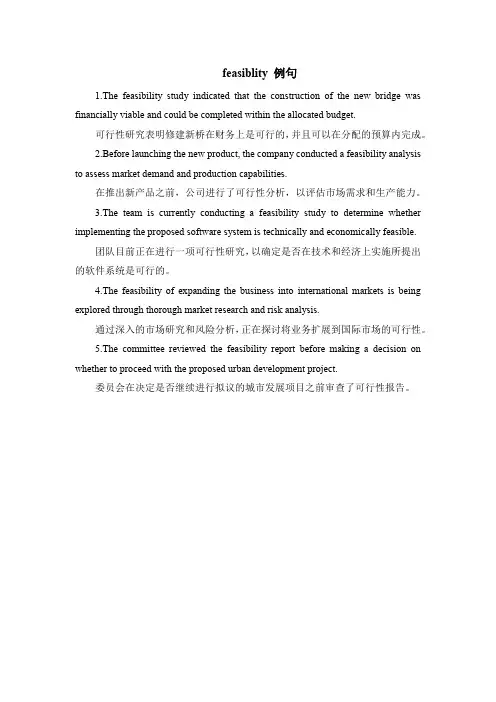
feasiblity 例句1.The feasibility study indicated that the construction of the new bridge was financially viable and could be completed within the allocated budget.可行性研究表明修建新桥在财务上是可行的,并且可以在分配的预算内完成。
2.Before launching the new product, the company conducted a feasibility analysis to assess market demand and production capabilities.在推出新产品之前,公司进行了可行性分析,以评估市场需求和生产能力。
3.The team is currently conducting a feasibility study to determine whether implementing the proposed software system is technically and economically feasible.团队目前正在进行一项可行性研究,以确定是否在技术和经济上实施所提出的软件系统是可行的。
4.The feasibility of expanding the business into international markets is being explored through thorough market research and risk analysis.通过深入的市场研究和风险分析,正在探讨将业务扩展到国际市场的可行性。
5.The committee reviewed the feasibility report before making a decision on whether to proceed with the proposed urban development project.委员会在决定是否继续进行拟议的城市发展项目之前审查了可行性报告。
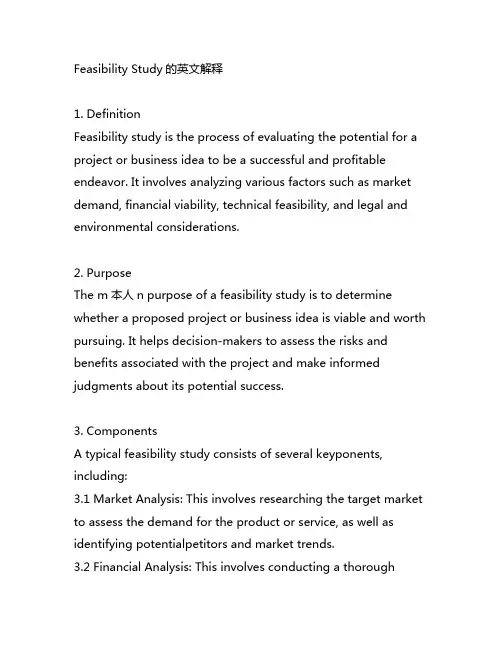
Feasibility Study的英文解释1. DefinitionFeasibility study is the process of evaluating the potential for a project or business idea to be a successful and profitable endeavor. It involves analyzing various factors such as market demand, financial viability, technical feasibility, and legal and environmental considerations.2. PurposeThe m本人n purpose of a feasibility study is to determine whether a proposed project or business idea is viable and worth pursuing. It helps decision-makers to assess the risks and benefits associated with the project and make informed judgments about its potential success.3. ComponentsA typical feasibility study consists of several keyponents, including:3.1 Market Analysis: This involves researching the target market to assess the demand for the product or service, as well as identifying potentialpetitors and market trends.3.2 Financial Analysis: This involves conducting a thoroughassessment of the financial implications of the project, including cost estimates, revenue projections, and potential return on investment.3.3 Technical Analysis: This involves evaluating the technical requirements and capabilities needed to implement the project, such as the av本人lability of resources and expertise.3.4 Legal and Environmental Analysis: This involves assessing the legal and regulatory requirements, as well as the potential environmental impact of the project.4. ProcessThe process of conducting a feasibility study typically involves the following steps:4.1 Identifying the need for the study: This involves determining the specific objectives and goals of the project, as well as the potential benefits and risks.4.2 Data collection: This involves gathering relevant information and data related to the project, including market research, financial records, and technical specifications.4.3 Analysis: This involves analyzing the collected data to evaluate the feasibility of the project, including conducting cost-benefit analysis and risk assessment.4.4 Report preparation: This involves documenting the findingsand rmendations of the feasibility study in a det本人led report, which is presented to the relevant stakeholders for decision-making.5. BenefitsThe benefits of conducting a feasibility study include:5.1 Minimizing risks: By identifying potential obstacles and challenges, a feasibility study helps to minimize the risks associated with the project.5.2 Informed decision-making: A feasibility study provides decision-makers with the necessary information to make informed judgments about the project's viability and potential for success.5.3 Cost savings: By identifying potential pitfalls and challenges early on, a feasibility study can help to avoid costly mistakes and inefficiencies.6. ConclusionOverall, a feasibility study is an essential tool for evaluating the potential of a project or business idea. By assessing various factors such as market demand, financial viability, technical feasibility, and legal and environmental considerations, a feasibility study helps decision-makers to make informedjudgments about the viability and potential success of the project. It is an important step in the planning and development of any new venture, and can significantly impact the ultimate success or f本人lure of the project.。
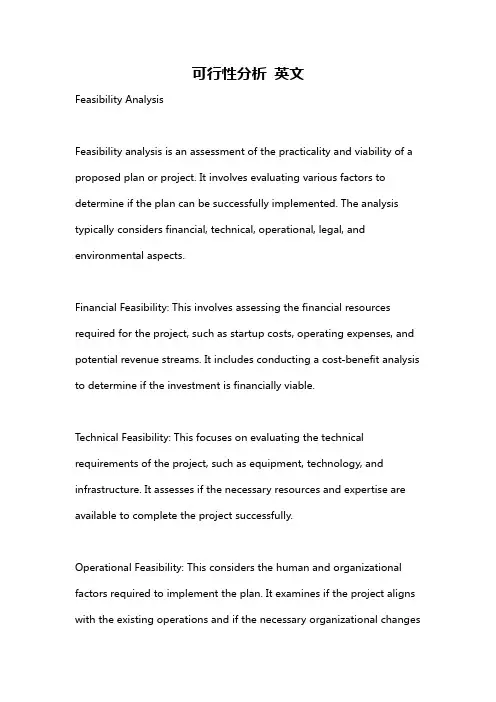
可行性分析英文Feasibility AnalysisFeasibility analysis is an assessment of the practicality and viability of a proposed plan or project. It involves evaluating various factors to determine if the plan can be successfully implemented. The analysis typically considers financial, technical, operational, legal, and environmental aspects.Financial Feasibility: This involves assessing the financial resources required for the project, such as startup costs, operating expenses, and potential revenue streams. It includes conducting a cost-benefit analysis to determine if the investment is financially viable.Technical Feasibility: This focuses on evaluating the technical requirements of the project, such as equipment, technology, and infrastructure. It assesses if the necessary resources and expertise are available to complete the project successfully.Operational Feasibility: This considers the human and organizational factors required to implement the plan. It examines if the project aligns with the existing operations and if the necessary organizational changescan be made.Legal Feasibility: This involves evaluating the legal and regulatory requirements associated with the project. It ensures that the plan complies with applicable laws and regulations.Environmental Feasibility: This assesses the impact of the project on the environment. It evaluates potential negative consequences and explores ways to mitigate any environmental risks.Feasibility analysis helps decision-makers determine if a proposed plan or project is practical and worth pursuing. It identifies potential obstacles and risks that may occur during implementation and provides insights to make informed decisions.。
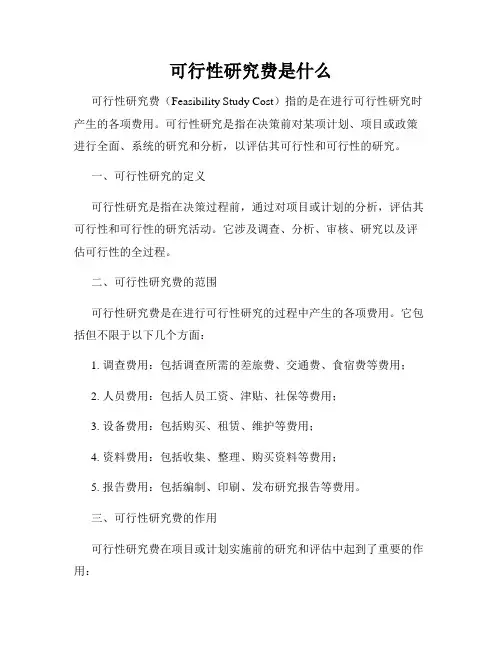
可行性研究费是什么可行性研究费(Feasibility Study Cost)指的是在进行可行性研究时产生的各项费用。
可行性研究是指在决策前对某项计划、项目或政策进行全面、系统的研究和分析,以评估其可行性和可行性的研究。
一、可行性研究的定义可行性研究是指在决策过程前,通过对项目或计划的分析,评估其可行性和可行性的研究活动。
它涉及调查、分析、审核、研究以及评估可行性的全过程。
二、可行性研究费的范围可行性研究费是在进行可行性研究的过程中产生的各项费用。
它包括但不限于以下几个方面:1. 调查费用:包括调查所需的差旅费、交通费、食宿费等费用;2. 人员费用:包括人员工资、津贴、社保等费用;3. 设备费用:包括购买、租赁、维护等费用;4. 资料费用:包括收集、整理、购买资料等费用;5. 报告费用:包括编制、印刷、发布研究报告等费用。
三、可行性研究费的作用可行性研究费在项目或计划实施前的研究和评估中起到了重要的作用:1. 提供决策依据:通过可行性研究,可以为管理层提供全面、准确的数据和信息,帮助管理者进行决策;2. 评估项目可行性:可行性研究费用用于评估项目的可行性,包括技术、市场、经济、法律和人力资源等方面的可行性;3. 风险分析和控制:可行性研究费用还可以用于进行风险分析和控制,帮助管理层预测和规避潜在的风险;4. 评估投资效益:通过对投资效益的评估,可行性研究费用可以帮助管理层确定项目或计划的回报情况,从而做出更合理的决策;5. 组织资源分配:通过可行性研究费用的投入,可以合理地组织和分配资源,确保研究活动的顺利进行。
四、可行性研究费的重要性可行性研究费用对于项目或计划的决策和实施至关重要。
以下是它的重要性体现:1. 提高决策质量:适当的研究投入可以提高项目决策的质量,减少决策风险;2. 防止资源浪费:通过事先的可行性研究,可以发现项目存在的不可行性和问题,避免资源的浪费;3. 促进项目顺利实施:可行性研究费用可以帮助管理层全面评估项目的可行性,从而使项目在实施过程中更顺利;4. 为项目筹资提供依据:合理的可行性研究费用可以为项目的筹资提供依据,帮助公司或组织争取融资的机会。
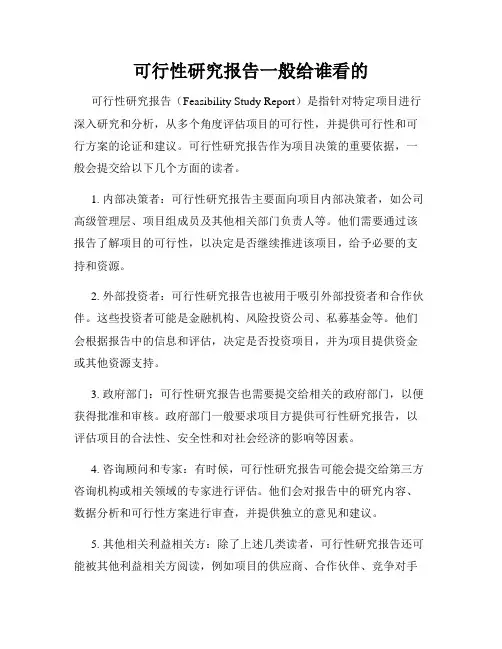
可行性研究报告一般给谁看的可行性研究报告(Feasibility Study Report)是指针对特定项目进行深入研究和分析,从多个角度评估项目的可行性,并提供可行性和可行方案的论证和建议。
可行性研究报告作为项目决策的重要依据,一般会提交给以下几个方面的读者。
1. 内部决策者:可行性研究报告主要面向项目内部决策者,如公司高级管理层、项目组成员及其他相关部门负责人等。
他们需要通过该报告了解项目的可行性,以决定是否继续推进该项目,给予必要的支持和资源。
2. 外部投资者:可行性研究报告也被用于吸引外部投资者和合作伙伴。
这些投资者可能是金融机构、风险投资公司、私募基金等。
他们会根据报告中的信息和评估,决定是否投资项目,并为项目提供资金或其他资源支持。
3. 政府部门:可行性研究报告也需要提交给相关的政府部门,以便获得批准和审核。
政府部门一般要求项目方提供可行性研究报告,以评估项目的合法性、安全性和对社会经济的影响等因素。
4. 咨询顾问和专家:有时候,可行性研究报告可能会提交给第三方咨询机构或相关领域的专家进行评估。
他们会对报告中的研究内容、数据分析和可行性方案进行审查,并提供独立的意见和建议。
5. 其他相关利益相关方:除了上述几类读者,可行性研究报告还可能被其他利益相关方阅读,例如项目的供应商、合作伙伴、竞争对手等。
这些相关方可能会根据报告内容调整自己的经营策略或者与项目方进行商务合作。
在编写可行性研究报告时,需要根据不同读者的需求和关注点来进行论述和陈述,确保报告内容准确、全面、清晰,并能够满足各方的信息需求。
此外,报告的排版要求整洁美观,语句通顺,条理清晰,以提升阅读体验。
总之,可行性研究报告的读者范围广泛,包括内部决策者、外部投资者、政府部门、咨询顾问和专家等等。
编写报告时,需要针对不同读者的需求进行论述,并确保报告内容准确、全面、清晰,以满足各方的信息需求。
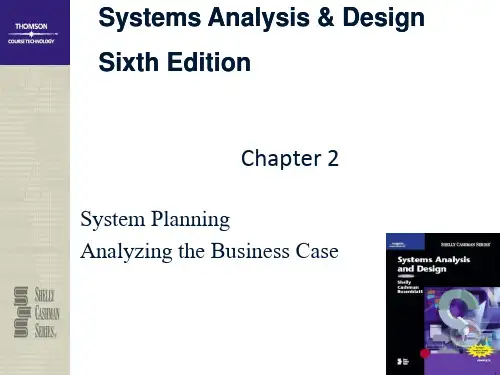
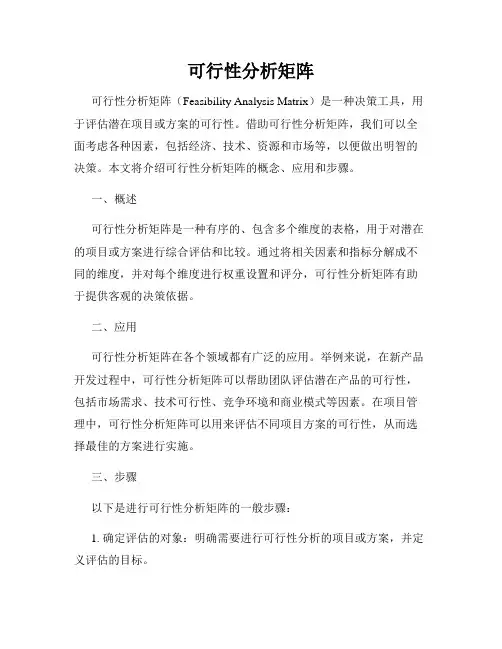
可行性分析矩阵可行性分析矩阵(Feasibility Analysis Matrix)是一种决策工具,用于评估潜在项目或方案的可行性。
借助可行性分析矩阵,我们可以全面考虑各种因素,包括经济、技术、资源和市场等,以便做出明智的决策。
本文将介绍可行性分析矩阵的概念、应用和步骤。
一、概述可行性分析矩阵是一种有序的、包含多个维度的表格,用于对潜在的项目或方案进行综合评估和比较。
通过将相关因素和指标分解成不同的维度,并对每个维度进行权重设置和评分,可行性分析矩阵有助于提供客观的决策依据。
二、应用可行性分析矩阵在各个领域都有广泛的应用。
举例来说,在新产品开发过程中,可行性分析矩阵可以帮助团队评估潜在产品的可行性,包括市场需求、技术可行性、竞争环境和商业模式等因素。
在项目管理中,可行性分析矩阵可以用来评估不同项目方案的可行性,从而选择最佳的方案进行实施。
三、步骤以下是进行可行性分析矩阵的一般步骤:1. 确定评估的对象:明确需要进行可行性分析的项目或方案,并定义评估的目标。
2. 确定评估的维度:根据项目或方案的特点,确定需要考虑的维度。
常见的维度包括经济、技术、资源、市场、法律和环境等。
3. 设定权重和评分:为每个维度设定权重和评分体系。
权重反映了各个维度的重要性,而评分则用于评估方案在每个维度上的表现。
4. 收集资料和数据:收集与各个维度相关的资料和数据,用于评估方案在每个维度上的表现。
5. 进行评估:根据设定的评分体系,对每个维度进行评估。
可以使用定量或定性的方法进行评估,最终得出综合评分。
6. 分析结果并做决策:根据综合评分,分析各个方案的优劣,并基于评估结果做出决策。
四、案例分析为了更好地理解可行性分析矩阵的应用,我们以某公司开发新产品的决策为例进行分析。
在这个例子中,我们将考虑经济、技术和市场三个维度。
经济维度包括成本、利润和回收期等指标;技术维度则包括技术可行性和研发难度等指标;市场维度则关注市场需求和竞争环境等指标。
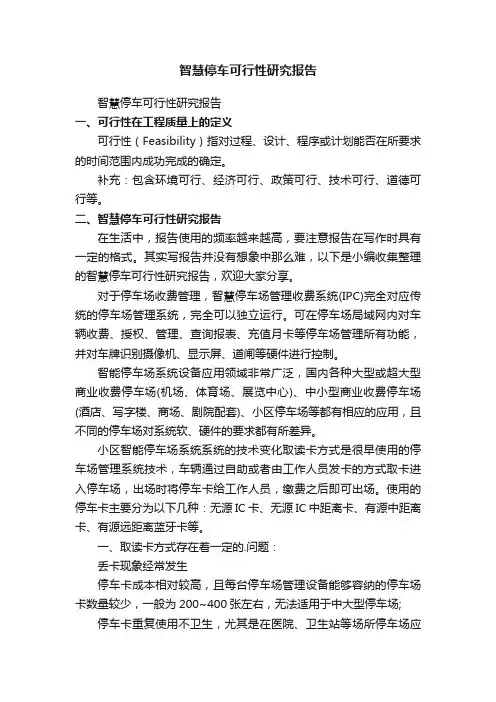
智慧停车可行性研究报告智慧停车可行性研究报告一、可行性在工程质量上的定义可行性(Feasibility)指对过程、设计、程序或计划能否在所要求的时间范围内成功完成的确定。
补充:包含环境可行、经济可行、政策可行、技术可行、道德可行等。
二、智慧停车可行性研究报告在生活中,报告使用的频率越来越高,要注意报告在写作时具有一定的格式。
其实写报告并没有想象中那么难,以下是小编收集整理的智慧停车可行性研究报告,欢迎大家分享。
对于停车场收费管理,智慧停车场管理收费系统(IPC)完全对应传统的停车场管理系统,完全可以独立运行。
可在停车场局域网内对车辆收费、授权、管理、查询报表、充值月卡等停车场管理所有功能,并对车牌识别摄像机、显示屏、道闸等硬件进行控制。
智能停车场系统设备应用领域非常广泛,国内各种大型或超大型商业收费停车场(机场、体育场、展览中心)、中小型商业收费停车场(酒店、写字楼、商场、剧院配套)、小区停车场等都有相应的应用,且不同的停车场对系统软、硬件的要求都有所差异。
小区智能停车场系统系统的技术变化取读卡方式是很早使用的停车场管理系统技术,车辆通过自助或者由工作人员发卡的方式取卡进入停车场,出场时将停车卡给工作人员,缴费之后即可出场。
使用的停车卡主要分为以下几种:无源IC卡、无源IC中距离卡、有源中距离卡、有源远距离蓝牙卡等。
一、取读卡方式存在着一定的.问题:丢卡现象经常发生停车卡成本相对较高,且每台停车场管理设备能够容纳的停车场卡数量较少,一般为200~400张左右,无法适用于中大型停车场;停车卡重复使用不卫生,尤其是在医院、卫生站等场所停车场应用中更为凸显。
针对以上存在的问题,取读票方式应运而生。
目前,使用较为广泛的还是卡票结合,即一套设备既可以使用读卡,又可以采用取票,内部车辆使用读卡方式,而临时车辆使用取读票的.形式进出停车场。
二、取读票方式能够实现以下几个功能:停车信息在停车票上一目了然。
控制机吐票前会自动将相关的停车信息打印在纸票上,如车牌号码、车辆类型、进入地点、进入时间和到期时间等信息,让车主一目了然,同时还减少了费用争议。
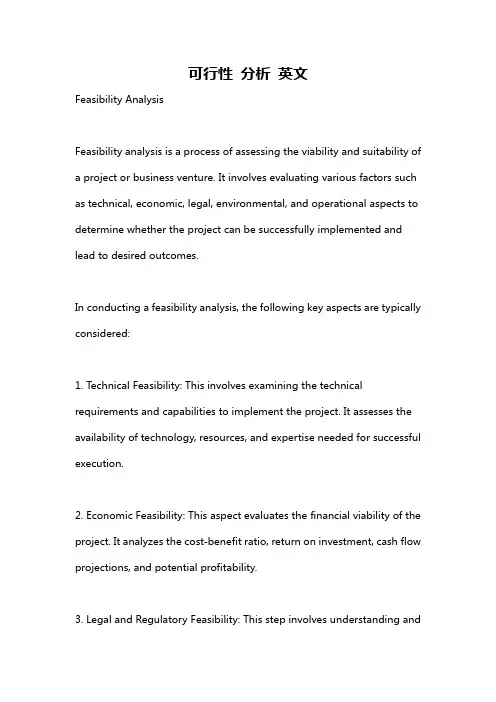
可行性分析英文Feasibility AnalysisFeasibility analysis is a process of assessing the viability and suitability of a project or business venture. It involves evaluating various factors such as technical, economic, legal, environmental, and operational aspects to determine whether the project can be successfully implemented and lead to desired outcomes.In conducting a feasibility analysis, the following key aspects are typically considered:1. Technical Feasibility: This involves examining the technical requirements and capabilities to implement the project. It assesses the availability of technology, resources, and expertise needed for successful execution.2. Economic Feasibility: This aspect evaluates the financial viability of the project. It analyzes the cost-benefit ratio, return on investment, cash flow projections, and potential profitability.3. Legal and Regulatory Feasibility: This step involves understanding andcomplying with applicable laws, regulations, and licensing requirements. It ensures that the project can be legally and ethically implemented.4. Environmental Feasibility: Environmental impact assessment is done to ascertain the potential effects of the project on the environment. It includes evaluating factors such as pollution control, sustainability, and resource consumption.5. Operational Feasibility: This assesses whether the project can be effectively managed and integrated into existing operations. It considers factors such as staffing, training, maintenance, and scalability.The outcome of a feasibility analysis helps in making informed decisions regarding the viability of the project. It provides insights into potential risks, challenges, and areas of improvement.Overall, a feasibility analysis aims to determine whether a project is worth pursuing, guiding stakeholders in making informed decisions based on a thorough understanding of its potential benefits and drawbacks.。
项目管理fsr阶段
在项目管理中,FSR阶段指的是项目前期研究阶段
(Feasibility Study Report),通常是项目启动阶段的一部分。
在这个阶段,项目团队会对项目的可行性进行全面的研究和评估,
以确定项目是否值得投资和实施。
FSR阶段通常包括以下几个方面
的工作:
1. 项目背景和目标,在FSR阶段,项目团队会对项目的背景和
目标进行详细的分析和描述,包括项目的发起原因、目的和预期成果。
2. 市场分析,在项目启动阶段,进行市场分析是至关重要的,
团队需要评估市场的需求和趋势,确定项目的市场定位和竞争优势。
3. 技术可行性,团队会评估项目所需的技术和资源是否可行,
包括技术方案的可行性、技术风险和技术支持等方面。
4. 经济可行性,在FSR阶段,团队会进行经济效益分析,评估
项目的投资回报率、成本效益和财务风险等,以确定项目的经济可
行性。
5. 法律和政策可行性,团队会对项目相关的法律法规和政策进行调研和评估,确保项目的合规性和可行性。
6. 风险评估,在FSR阶段,团队会对项目可能面临的各种风险进行评估和分析,包括市场风险、技术风险、政策风险等,以制定相应的风险管理计划。
总的来说,FSR阶段是项目管理中非常重要的一个阶段,通过对项目的全面评估和分析,可以帮助决策者确定项目的可行性,为项目的后续实施提供重要的依据。
在这个阶段,团队需要全面考虑项目的各个方面,从而确保项目的顺利实施和成功完成。
临床试验可行性分析是什么临床试验可行性分析(feasibility analysis of clinical trials)是指在进行临床试验之前对试验可行性的评估和分析。
其目的是确定临床试验的可行性,包括试验设计的可行性、试验执行的可行性以及试验目标的可行性。
通过可行性分析,可以评估试验是否有足够的资源和条件进行,并有望达到预期的研究目标。
临床试验可行性分析通常包括以下几个方面的内容:1. 试验设计的可行性:试验设计的可行性是指评估试验方案是否具备科学性和可实施性。
首先考虑的是研究问题的科学性,即试验是否能够回答所提出的科学假设。
其次,还需要评估试验的样本量是否足够,并根据试验目的和预期效应的大小来计算样本量。
此外,还需要考虑试验的随机分组、盲法等相关设计要素是否可行。
2. 试验执行的可行性:试验执行的可行性是指评估试验是否有足够的资源和条件来保证试验的进行。
包括以下方面:人力资源,包括试验人员的专业背景和能力;物力资源,包括试验设备和试验药物、材料等的供应;财务资源,包括试验经费的来源和预计支出等。
另外,还需要评估试验所涉及的流程和操作是否能够符合相关法规和伦理要求。
3. 试验目标的可行性:试验目标的可行性是指评估试验的目标是否可行和有意义。
首先需要明确试验的目标是什么,例如是为了评估新药的疗效和安全性,还是为了评估某种诊断方法的准确性等。
此外,还需要考虑试验结果对临床实践和患者的实际效益是否具有现实意义。
在进行临床试验可行性分析时,还需要考虑一些其他的因素:1. 人群的可招募性:试验是否能够招募到符合入选标准的患者。
如果试验的入选标准太严格或者患者数量不足,可能会导致招募困难,影响试验的可行性。
2. 临床实际情况:评估试验方案和目标是否符合临床实际情况,是否能够得到医生和患者的支持和合作。
3. 伦理和法规要求的可满足性:评估试验是否符合伦理和法规要求,包括研究伦理委员会的审批和监管机构的要求等。
可行性分析英文Feasibility AnalysisFeasibility analysis is a process of assessing the practicality and viability of a project or business venture. It involves evaluating the potential success and challenges associated with implementing the proposed idea. Below are the key aspects typically considered during a feasibility analysis:1. Market Feasibility: This examines the demand and potential market for the product or service being offered. It involves assessing market trends, competition, target customers, and potential market share.2. Technical Feasibility: This assesses whether the proposed project can be successfully implemented from a technical perspective. It involves evaluating the required technology, infrastructure, resources, and expertise.3. Financial Feasibility: This involves reviewing the financial aspects of the project, including the cost of implementation, potential revenue, profitability, and return on investment. It also considers the availability of funds, potential sources of financing, and the project's financial viability.4. Legal Feasibility: This examines the legal and regulatory aspects associated with the project. It involves evaluating the compliance requirements, permits, licenses, intellectual property rights, and any potential legal obstacles.5. Operational Feasibility: This assesses whether the project can be effectively and efficiently operated on an ongoing basis. It considers factors such as the availability of resources, workforce, skills, and operational processes.6. Environmental Feasibility: This evaluates the impact of the project on the environment and sustainability. It involves assessing potential environmental risks, compliance with environmental regulations, and the overall sustainability of the project.By conducting a thorough feasibility analysis, businesses and entrepreneurs can make informed decisions and determine whether a project is worth pursuing. This analysis helps identify potential risks, challenges, and opportunities and allows for necessary adjustments in the planning and execution stages.。
可行性分析英文Feasibility Analysis: A Comprehensive Assessment for Business SuccessIntroductionFeasibility analysis is a critical stage in establishing a business, developing a new product, or expanding operations. It is an evaluation of the capacity of an idea or plan to be implemented successfully. Conducting a feasibility analysis helps entrepreneurs determine the viability of their business idea, assess the potential risks, and devise a comprehensive plan that adapts to the market conditions. This article aims to provide a holistic understanding of feasibility analysis, discussing its benefits, purpose, components, and types.Benefits of Feasibility AnalysisComprehensive feasibility analysis assists entrepreneurs in analyzing the market trends, potential risks, and competition. It enables them to make informed decisions and develop a robust plan that can optimize the business to meet the specific market requirements. Conducting feasibility analysis assists in identifying the targetcustomers, analyzing the market size, assessing the profitability of the business. It helps in determining the best ways to optimize resources, precise budgeting, and cost control.Purpose of Feasibility AnalysisThe primary purpose of feasibility analysis is to assess the viability of the business idea by evaluating if it can be implemented in the present market conditions. It helps entrepreneurs plan, strategize, and allocate resources to maximize the business's potential. The feasibility analysis helps in identifying the gaps in the market and developing a unique selling proposition that can attract target customers. It is important to conduct a feasibility analysis to assess if an innovative product idea or business concept can translate into profits.Components of Feasibility AnalysisMarket Analysis: The market analysis provides a detailed understanding of the present market conditions for the proposed product or service. It identifies the target audience, their preferences, and behavior. It also analyzes competitors' strategies, potential barriers or challenges, and current trends in the market.Technical Feasibility: The technical feasibility assesses if the proposed product or service can be developed using available technology. It evaluates the capability and complexity of the infrastructure, machinery, equipment, and software required to develop and deliver the product or service.Financial Feasibility: The financial feasibility estimates the financial requirements for establishing or expanding the business. It considers the projected revenue, profit margins, expenses, and potential return on investment based on the market analysis.Operational Feasibility: The operational feasibility examines if the proposed product or service can be implemented efficiently. It evaluates the availability, quality, and skill sets of the workforce. It also evaluates the efficiency and effectiveness of business processes that will support the operations of the proposed product or service.Types of Feasibility AnalysisMarket Feasibility Analysis: The market feasibility analysis evaluates the market demand for a proposed product or service. It assesses the target audience's preferences, behavior, and willingness topay for the product or service. It also evaluates the competition, market size, current trends, and potential market share.Technical Feasibility Analysis: The technical feasibility analysis evaluates whether a proposed product or service can be developed using available technology. It considers the infrastructure, machinery, equipment, and software needed for product development.Financial Feasibility Analysis: The financial feasibility analysis estimates the financial requirements to establish or expand a business. It considers projected revenue, cost of goods sold, gross margin, operating expenses, break-even analysis, and potential return on investment.Operational Feasibility Analysis: The operational feasibility analysis evaluates whether a proposed product or service can be implemented efficiently. It considers the workforce capability, resources, and efficiency of existing business processes that will support the operations of the proposed product or service.ConclusionFeasibility analysis is a comprehensive assessment that assists entrepreneurs in evaluating their business idea. Conducting a feasibility analysis is critical to identifying the target audience, assessing profitability, and devising a robust business plan that adapts to market conditions. It involves evaluating the market demand, technical feasibility, financial feasibility, and operational feasibility. By conducting these assessments, entrepreneurs can maximize their business potential and mitigate potential risks. A well-executed feasibility analysis is essential in unlocking the success of any new business venture.。
Preprint of: J.K.Vanclay, 1995. Modelling land use patterns at the forest edge: feasibility of a static spatial model. In: Ecological Economics Conference, Coffs Harbour NSW 19-23 November 1995. Centre for Agricultural and Resource Economics, University of New England, Armidale, p. 79-84.Modelling land use patterns at the forest edge:Feasibility of a static spatial modelJerome K. VanclayCenter for International Forestry Research, Bogor, IndonesiaAbstractA model is proposed that will allow forest and land use policy options to be explored in a repeatable, objective and quantitative way. Construction and use of the model should lead to a better understanding of spatial and temporal land use patterns. It will provide detailed spatially-explicit data on a range of parameters to enable rigorous testing and offer insights for further development. The model is based on the assumption that land use patterns ultimately are shaped by individuals who make rational decisions based on available information, obligations and expectations (social as well as economic). Since these decisions are rational, they, and the resulting land use patterns, can be modelled and predicted. In making these decisions, individuals balance the anticipated returns and risks, and individual strategies (i.e. emphasis on profit-maximization or risk minimization) reflect status and security. Important inputs to the model include spatial (land tenure, topography, soils), social (demography, clan obligations, cultural traditions), and economic data (crop yields, market prices, transport costs). Land use is not an input to the model, but the model can predict spatially-explicit land use patterns. Thus land use predictions may provide a robust way to test the model. The model can be implemented in a hierarchical way, so that it can operate at the village, provincial or national scale, with the detail of inputs and outputs varying accordingly.1. INTRODUCTIONOne of the weaknesses of much forest policy research is the difficulty of demonstrating robust empirical tests of the propositions. One way to allow more robust testing is to model the social and ecological factors of interest, and compare model predictions with empirical data. Although such models seem feasible, no spatially-explicit models of this kind appear to have been implemented to date. Models are not the only way to test propositions, but a major attraction of formal modelling is that ideas must be expressed completely, concisely and explicitly, and implemented in an integrated and testable way. They also offer new insights and pose new problems for research: “More information can be read from a map than was needed to construct it” (Ziman 1978).In this paper, I discuss the rationale for a model designed to improve understanding of land use patterns in time and space, especially near the forest edge, and to explore in a quantitative way, policy options intended to manipulate these patterns. It is inevitable that initial attempts to construct models of this kind will be simplistic. However, simple models may still offer powerful insights. In particular, models excel at exposing counter-intuitive consequences of simple assumptions. Even if initial prototypes of the model are of little practical relevance, these prototypes may offer valuable insights, and their main purpose may be to focus questions rather than to provide answers.The basic concepts in this work are not new; what is new is the way concepts are integrated and applied. Much of this work develops from the basis established by von Thünen (1826). Some recent work (e.g. Dunning et al 1995, Flechsig et al 1994, Wilkie and Finn 1988, Lambin 1994) touches on the concepts expounded here, but the particular implementation proposed here appears to have been neglected. Other models (e.g. de Klein 1989, Iskandar 1993, DeShazo and DeShazo 1995, Chomitz and Gray 1995) exploring a similar topic using analogous approaches (viz. system-dynamics) have not attempted spatially-explicit predictions, an important aspect for model testing. The danger of confabulation (sensu Crick 1995, p.170, i.e. a plausible but irrelevant explanation) is increased in the more general and smaller-scale models (e.g., models at the national and regional level), and this may be minimized by working at the largest practicable scale.Testing remains one of the weak points in much modelling work (e.g. Meadows and Robinson 1985, Vanclay et al 1995), and socio-economic models are no exception. Although many useful insights may be gained by examining model structure and implications, this is no substitute for formal empirical tests, sincesubjective appraisals may be misleading (even with comparatively straight forward appraisals of technical equipment, e.g. Skovsgaard et al. 1995).The proposed model should provide detailed spatially-explicit data on a range of parameters to enable on-going development and testing. Map-based summaries may be a particularly useful form of output that is easily interpreted and tested. However, map-based output is feasible only at the village scale, and appears impractical at the national scale, so aggregate indices such as social indicators of well-being and equality, and ecological indicators of biodiversity and sustainability will also be provided. If spatially-explicit predictions are not required, it may be possible to generalize other aspects of the model while maintaining compatible predictions (cf. Daniels and Burkhart 1988).2. ASSUMPTIONSThe proposed model relies on five basic assumptions, namely that:nd use patterns are ultimately shaped by individuals and groups of individuals;2.These individuals make rational decisions based on available information, obligations and expectations(social as well as economic; note that the individual’s perceptions may be more important than reality);3.Individuals explore all options available to them, within the constraints imposed by resources, finances,skills and knowledge.4.Individuals tend to maximize expected benefits or to minimize anticipated risks to themselves, theirfamilies and their clans;5.Both benefit-seeking and risk-avoidance can be modelled by maximizing the risk-adjusted benefits (seebelow).Assumption 2 concerning rational behaviour is perhaps the most controversial of these assumptions, and warrants further discussion. I use “rational” to denote an objective decision that can be justified in quantitative terms, and which is thus amenable to numerical simulation. While this seems reasonable in many situations, some communities may rely, in part, on omens (e.g. dreams, divining, augury) to guide land use decisions. While such behaviour may be rational in some senses (e.g. non-systematic cultivation practices may spread risks and thus increase overall benefit to a community, see e.g. Dove 1993), they maynot be rational in a modelling sense. For simplicity, initial prototypes of the model introduced here will be deterministic, and although a stochastic implementation is possible, simple random selection may not adequately reflect the intricacies of the use of omens (e.g. Dove 1993).In the simplest case, these assumptions (and the model outlined below) apply to agricultural monocultures, but conceptually, the same approach may be applied to the collection of forest products (wood or non-wood products), to mixed plantings (e.g. agroforestry, with a little additional complexity in formulating yield tables) and to alternative employment opportunities (including industrial employment).Decisions affecting land use patterns may typically involve the production of one or more products to achieve the maximum benefit subject to some social and economic constraints. This benefit may be adjusted to account for risk-avoidance by introducing a suitable discount factor to account for the anticipated risk (see below). Thus the benefit to an individual k may be estimated by choosing activities i and sites j so as to maximizeΣj{Max i [Yield ij × Price ij × Risk ijk × Share ijk – Input ij – Sell ij ]}(1)subject to the constraints imposed by available resources. In non-mathematical terms, choose the “best” combination of activities for each of the sites available to the individual, so that the overall benefit to the individual is maximized. Note that “best” depends on many things: the anticipated yield for that activity (e.g. crop, handicraft item, wage-based employment, etc.) at that site, the anticipated price, any reduction for real or imagined risks (pests, disease, fire, theft, loss of tenure, spoiling during transport to market, viability of an employer, etc.), an allowance for shares that others may have in the activity (clan obligations as well as landlords who may share revenues but not costs). For efficiency, the prototype model will assume that yields and prices are the same for all individuals (ignoring production and negotiating skills), but will recognize that individuals may differ in their willingness to accept risks, and in their social obligations. Notice that the correction for risk (Risk ijk in equation 1) may reflect the long-run expectation for individuals who are not risk-adverse, but may be substantially less for those who are unable or unwilling to contemplate a risky venture. A suitable risk adjustment may be based on the observed coefficient of variation of yields and prices using a relationship such as Risk = 1 – Aversion× CV(Benefit), where, for example, Aversion may be a function of an individual’s age and assets. The gross return to the individual is adjusted for the costs of production (Input ij) and the costs of marketing (Sell ij). Note that these also depend on the product and thesite. Production costs may include labour (own or paid), rent (formal or informal obligations), and other inputs (fertilizers, pesticides, etc.). The inclusion of some estimate of the value of an individual’s own labour may not influence the outcome of the model greatly, but may be a useful way to discriminate “enjoyable” and “unpleasant” work. Individuals may undertake activities because of the status conferred, and the production cost may need to be adjusted for this perceived status. Marketing costs may include transport and packing, and in some situations, advertising.The terms in equation (1) can all be quantified in some sense, so it should be possible to construct and evaluate this model, provided that we can quantify them all in similar units (e.g. dollars or other local currency). Note that history does not enter this equation, except in that it influences the choice of activities i entertained by each individual. This could be formulated as a mathematical programming exercise, but it is probably sufficient (at least initially) to solve it heuristically (i.e. trial and error with a simple set of guidelines). This is not a typical linear programming problem formulation which maximizes overall benefits, as each individual may attempt to find an optimal solution for their family or clan, even if it leads to a sub-optimal outcome for the village as a whole (cf. Hardin 1968). However, in common with classical linear programming, it shares the need to recognize constraints such as the time, land and assets available to each individual.The decision made for any particular site j is not independent of decisions made for other sites, since price and risk may depend on total production across all sites and many land use options may have off-site impacts (e.g., pollution, erosion, etc.). Over-production of staple goods may saturate local markets, and conversely, underproduction of export-oriented goods may encounter problems with economies of scale in marketing and handling. For products produced and consumed locally, it is appropriate that the model should ultimately account for total demand and price elasticity, but this introduces several complexities and will be omitted from initial prototypes. It is also desirable to include lagged adjustments to take into account the time taken to learn and implement new technologies (and meet transition costs). However, in an initial prototype of the model, we could avoid this complexity by making the prevailing market prices exogenous to the model, getting the user to provide the prices and assuming that they remain constant. This avoids many complexities, since the actual prices paid may depend on elasticity, the number of producers and buyers, and local wealth (individuals tend to substitute luxury for inferior goods as their personal wealth increases). Italso simplifies the model since we can then assume decisions on any site are independent of other sites, so that equation (1) can be solved without taking topology into account.Some further simplification allows the model to be implemented as a static spatial model. Static in the sense that parameters do not change over time, and spatial since predictions will be spatially explicit and thus able to be mapped and checked on the ground. One attraction of a spatial model is the rigorous testing that is possible when spatial predictions are provided. Spatial models also simplify many of the feedback loops represented in other models (e.g. relationship such as “more cultivation → less forest”) become self-evident in a spatially explicit model..3. PROPOSED IMPLEMENTATIONAs outlined above, the model could be used in a mathematical way to evaluate land use options for a few sites, but to put it into a useful context, it should be implemented within a geographic information system (GIS) framework. If one or two elements of the equation are provided as exogenous inputs (e.g. prices), the equation can be deterministic, and independent of time, so that all the details needed to evaluate decisions can be taken from data normally available in a GIS, e.g.Predict fromYields soils, topography, climate, yield tables and modelsPrices exogenous data for each product or activityRisk CV(benefits), tenure, topography, socio-politicsShare tenure, social obligationsInputs soils, existing vegetation, capital, cultural traditionsSell distance, transport systems, marketsMany of these raw data requirements can be obtained from a conventional GIS, which typically may provide information such as soils, topography (i.e. digital elevation model), climate, vegetation, tenure, transport routes and urban areas. Crop yields may be estimated from historic data, standard yield tables, orfrom software such as Plantgro (Hackett 1991). Costs of marketing may be estimated from the time and energy expended in transporting the product by road, rail, river and beasts of burden.Since land use does not enter, but can be predicted by, equation (1), the predicted land use patterns may provide a robust test of the model. However, care will be required in interpreting such comparisons, and it may be appropriate to amalgamate some activities into broad classes to provide realistic comparisons and focus attention on the most important limitations of the model.4. OUTPUTSThe model should provide a range of outputs to suit different user requirements. One visible output would be a GIS “picture” that responds to changes in input parameters, allowing users to gain a visual impression of land use changes occurring in response to changes in policies and other instruments. Under some scenarios, predicted land uses may remain relatively static, despite moderate perturbations in input variables and model parameters. We want to identify the “sensitive” areas, where comparatively small perturbations in inputs and assumptions give rise to large changes in predictions. In particular, we want to know where these areas are, what parameters trigger shifts in dominant land use, and how these shifts occur. One useful way to emphasize such changes is to compare predictions under two (or more) scenarios, and to map the difference in outcomes. Another possibility is to plot isolines showing the price change in the product of interest that is likely to result in land use change (e.g. degradation or deforestation as a result of lower transport costs or higher prices for cash crops). Preconceptions suggest that these sensitive areas may be near the forest edge, and may include Imperata grasslands. However, to establish or refute this, we need sensitivity analyses on all input parameters. While this sensitivity testing is critical to both understand and check the model, it is also an important outcome of the modelling exercise.Other users of the model may not seek spatial output from the model, but look for aggregate indices indicating overall environmental and human welfare, and with some ingenuity, it should be possible to compute suitable indices from variables in the model. Some possibilities include indices of human welfare computed from household income, nutrition and leisure time; indices of resource wealth analogous to land expectation values; environmental indicators based on the relative area, harvesting (including hunting) pressure, and structural diversity of forest. The model may be amenable to approximate indicators of waterquality, but it is unlikely that useful measures of biodiversity can be gleaned from the model as currently proposed.5. CHALLENGESThere are several specific problems that need to be addressed before this model can be realized in its proposed form.Data collection: In the proposed model formulation, the underlying functional relationships may be rather simple, but the data requirements become quite demanding. Equation (1) and the table above appear innocent enough, but they reveal the need for anticipated yields and prices of all possible crops under a range of situations, detailed tenure and demographic data, and a good understanding of the socio-economic culture of the community. This is a major undertaking, and may be a major limitation of the model. In initial prototypes involving a limited geographic area, it is desirable to have a complete census of all inhabitants to allow thorough model testing, but subsequent operational implementations may sample only selected individuals to reduce the burden of data acquisition.Travel costs: Effective valuation of production and marketing requires efficient travel cost/time algorithms based on GIS data. Algorithms currently available appear to be rather simplistic raster-based approximations (e.g. Wilkie and Finn 1988), and efficient generalizations of these methods will be necessary for reliable predictions.Valuing intangibles: To be implemented effectively, all components of the model need to be quantified in the same units (e.g. dollars). One of the challenges in constructing the model will be to find ways to value the intangibles involved with land use decisions, such as land area (e.g., farmers may purchase land at prices inconsistent with production for the prestige of owning a bigger farm), size of herd (e.g., because of the perceived prestige associated with a large herd, graziers tend to have herds near the maximum carrying capacity, even though a lower stocking may offer equivalent returns and lower risk), possession or production of prestigious items, etc.Dynamics: If conditions change so that land use becomes less intensive, natural vegetation may not reappear immediately, but may take time to regenerate. This has implications for other land uses, as the nature of existing vegetation may influence land use decisions (e.g. cost of clearing or weeding; potential toharvest established plants/trees). This “fallow” or regenerating “abandoned” land may be best modelled dynamically. It seems inefficient to dynamically model every cell in the GIS, so selected sites may form the basis for interpolation. Techniques such as adaptive simulated annealing may provide a near-optimal basis for sampling (e.g. Ingber 1993). We may also need dynamic models to be able to investigate whether a given level of harvesting (of timber or non-timber products) in forested areas is sustainable, or if not, to calculate time to depletion. A further challenge for later versions will be to model species interactions (both plant and animal species), especially for apparently pivotal (keystone) species, as these may influence regrowth on “abandoned” land.Scaling-up: The proposal outlined above is easy to conceive for a small village, where we can include every individual in the solution to equation (1). However, as we scale up to include a bigger populations, we cannot examine decision-making individual-by-individual, and must extrapolate from a sample of individuals. The choice of sample may be critical to the outcome, and suitable sampling strategies must be investigated before the approach can be scaled-up to the local, provincial or national level. A crucial part of this is to identify the minimum essential set of prime determinants. If we can agree that land use is shaped primarily by one or two factors, e.g. transport costs and alternative employment opportunities, then we will be able to construct an efficient model at the national level using data drawn largely from GIS systems. However, as the number of critical determinants increases, the computational load and data requirement increases rapidly, and it may not be feasible to scale-up a complex detailed model. Hence simplicity is a great advantage in applying the model.6. PROGNOSISFeasibility: There are some major problems anticipated in collecting sufficient reliable data to calibrate and use the model, but it seems possible to overcome these, and to realize the model.Value: Is the proposed model worth pursuing? I make no attempt to conceal the difficulties of constructing and implementing a useful version of this model, but there are many benefits, including the knowledge and experience that will be learned during the attempt. The model will be completed in an iterative way, with many prototypes before a useful model is attained. Each prototype should offer the opportunity to test and refine ideas a little further, to advance our understanding and knowledge, and tofacilitate subsequent attempts. When a useful model is completed, it may revolutionize the way we explore forest policy options and land use implications.Practicality: As mentioned above, the demanding input requirements will limit the application of early prototypes of the model. However, it seems likely that sensitivity testing will reveal ways to simplify the model, and that inputs can be further reduced by judicious sampling and interpolation, thus relaxing input requirements.As Bower (cited in Crick 1995, p.177) observed, perhaps “the best test of a model is how well can the modeller answer the questions ‘What do you know now that you did not know before?’ and ‘How can you find out if it is true?’”. The proposed model is not without limitations, but by providing a fertile test-bed for ideas, offers a ample scope for furthering our knowledge of land use patterns. The prognosis seems sufficiently promising to continue with the prototype, at least until the first cycle of calibration and testing are completed.7. ACKNOWLEDGMENTSMany colleagues have shared helpful insights which have influenced the formulation of this model. I am especially grateful to Arild Angelsen, Neil Byron and Carol Colfer for helpful discussions and suggestions.8. REFERENCESChomitz, K and Gray, D., 1995. Roads, lands, markets and deforestation: a spatial model of land use in Belize. Policy Research Working Paper no 1444, Policy Research Dept, World Bank, Washington DC. Crick, F., 1995. The Astonishing Hypothesis: The scientific search for the soul. Touchstone, London, 317p. Daniels, , R.F. and Burkhart, H.E., 1988. An integrated system of forest stand models. Forest Ecology and Management 23:159-177.DeShazo, R.P and DeShazo, J.R., 1995. An economic model of smallholder deforestation: a consideration of the shadow value of land on the frontier. In: Ø. Sandbukt(editor), Management of Tropical Forests: Towards an Integrated Perspective, pp. 153-166, Centre for Development and the Environment,University of Oslo, Occasional Papers from SUM No. 1/95.Dove, M.R., 1993. Uncertainty, humility and adaptation in the tropical forest: the agricultural augury of the Kantu. Ethnology 40: 145-167.Dunning, J.B. Jr, Stewart, D.J., Danielson, B.J., Noon, B.R., Root, T.L, Lamberson, R.H. and Stevens, E.E., 1995. Spatially explicit population models: current forms and future uses. Ecological Applications 5: 3-11. Flechsig, M., Erhard, M., and Wenzel, V., 1994. Simulation-based regional models — concept, design and application. Ecological Modelling 75/76: 601-608.Hackett, C., 1991. Plantgro: a software package for coarse prediction of plant growth. CSIRO, Melbourne. Hardin, G.J., 1968. The tragedy of the commons. Science 162: 1243-1248.Ingber, A.L., 1993. Simulated annealing: Practice versus theory. J Mathl. Comput. Modelling 18: 29-57. Iskandar, J., 1993. System dynamic modelling for prediction and evaluation of the future natural resources use in Seberida, Sumatra, Indonesia. In Rain Forest and Resource Management, Proceedings of theNORINDRA Seminar, Jakarta 25-26 May 1993, pp. 179-184.de Klein, J.P.G., 1989. Analysis of land use development: a system dynamics land use model for Gunung Kidul (Java). Fakultas Kehutanan, Universitas Gadjah Mada, FONC Project Communication No1989-5, 78 pp.Lambin, E.F., 1994. Modelling deforestation processes: a review. TREES Series B Research Report No 1 (EUR 15744), Luxembourg.Meadows, D.H. and Robinson, J.M., 1985. The Electronic Oracle: computer models and social decisions.Wiley, xv+445 pp., Chichester.Skovsgaard, J.P., Johannsen, V.K., and Vanclay, J.K., 1995. Laser dendrometers in forestry: tools or toys? In: L. Bren and C. Greenwood (editor), Applications of New Technologies in Forestr y, pp. 289-298, Institute of Foresters of Australia, Canberra.Thünen, J.H. von, 1966. Der Isolierte Staat in Beziehung auf Landwirtschaft und Nationalökonomie, 1826.English translation by P. Hall Von Thünen’s Isolated State. Pergamon Press.Vanclay, J.K., Skovsgaard, J.P. and Garcia, O., 1995. Evaluating forest growth models. Paper presented at International Union of Forestry Research Organizations (IUFRO) XX Congress, Tampere, Finland, 6-12 August.Wilkie, D.S. and Finn, J.T., 1988. A spatial model of land use and forest regeneration in the Ituri forest of northeastern Zaire. Ecological Modelling 41: 307-323.Ziman, J., 1978. Reliable Knowledge: an exploration of the grounds for belief in science. Cambridge Univ.Press, 197 pp., Cambridge.。